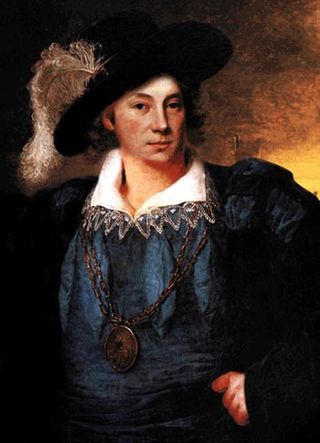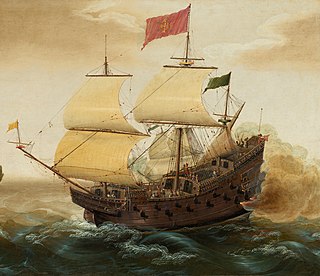
The Anglo-Spanish War was a conflict between the English Protectorate under Oliver Cromwell, and Spain, between 1654 and 1660. It was caused by commercial rivalry. Each side attacked the other's commercial and colonial interests in various ways such as privateering and naval expeditions. In 1655, an English amphibious expedition invaded Spanish territory in the Caribbean. In 1657, England formed an alliance with France, merging the Anglo–Spanish war with the larger Franco-Spanish War resulting in major land actions that took place in the Spanish Netherlands.

Laurens Cornelis Boudewijn de Graaf was a Dutch pirate, mercenary, and naval officer in the service of the French colony of Saint-Domingue during the late 17th and early 18th century.
John Morris was an English buccaneer active in the Caribbean during the 1660s and early-1670s. His son, John Morris the Younger, held a command of his own ship during his father's later expeditions against Portobelo and Maracaibo. John Morris the Younger was one of the commanders killed in an explosion during a party on board Henry Morgan's flagship in 1670.

The Battle of San Juan was a military and naval action on June 15, 1598 when an English force of 20 ships and 1,700 men under Sir George Clifford, Earl of Cumberland, overwhelmed and took the Spanish fortress Castillo San Felipe del Morro and thus took the city of San Juan, Puerto Rico. They were able to hold the castle for 65 days but disease took its toll and the English forces left, but not before sacking and burning San Juan to the ground. This was the only attack that broke through and captured El Morro castle.

The Capture of Fort Rocher took place on 9 February 1654, during the Franco-Spanish War (1635–1659). Equipped with one siege battery, a Spanish expedition of 700 troops attacked the buccaneer stronghold of Tortuga, capturing the Fort de Rocher and 500 prisoners including 330 buccaneers and goods valued at approximately 160,000 pieces-of-eight. The Spanish burned the colony to the ground and slaughtered its inhabitants, leaving behind a fort manned by 150 soldiers. They possessed the island for about eighteen months, but on the approach of the expedition under Penn and Venables were ordered by the Conde de Peñalva, Governor of Santo Domingo, to demolish the fortifications, bury the artillery and other arms, and retire to his aid in Hispaniola.

The Capture of Portobello was a military event during the Anglo–Spanish War in which an English expedition under the command of William Parker assaulted and took Portobello from the Spanish, acquired some booty, and then sacked the place.

The Battle of Santo Domingo (1586) or the Capture of Santo Domingo was a military and naval action fought on 1 January 1586, of the recently declared Anglo-Spanish War that resulted in the assault and capture by English soldiers and sailors of the Spanish city of Santo Domingo governed by Cristóbal de Ovalle on the Spanish island of Hispaniola. The English were led by Francis Drake and was part of his Great Expedition to raid the Spanish New World in a kind of preemptive strike. The English soldiers then occupied the city for over a month and captured much booty along with a 25,000 ducat ransom before departing on 1 February.
The Raid on Puerto Caballos was a military event that took place during the Anglo–Spanish War where a small expedition of ships funded and raised by the Earl of Cumberland was sent to the Caribbean under command of Captain James Langton. At Puerto Caballos on the coast of the Royal Audiencia of Guatemala in the New World empire of Spain on 16 March 1594, Langton raided the place and after a three-day battle won possession of seven ships under command of Diego Ramirez along with much booty.

The Battle of Puerto Caballos was a military event during the Anglo–Spanish War to capture the Spanish town and port of Puerto Caballos on 17 February 1603 by an English fleet under Christopher Newport and Michael Geare. The English were able to achieve victory after a bitter fight. Two Spanish galleons were captured, one of which was subsequently burned. The Anglo-French consortium occupied the area and after two weeks withdrew with captured booty.
The Raid on Tabasco, Capture of Tabasco or Newport's 2nd Expedition of 1599 was an English military expedition during the Anglo–Spanish War that captured the Spanish port settlement of Tabasco in New Spain. The English under Christopher Newport then occupied the town and gained a significant amount of booty before heading home.

The Battle of Flores (1592), also known as Cruising Voyage to the Azores of 1592, or the Capture of the Madre de Deus describes a series of naval engagements that took place from 20 May to 19 August 1592, during the Anglo-Spanish War. The battle was part of an expedition by an English fleet initially led by Sir Walter Raleigh, and then by Martin Frobisher and John Burgh. The expedition involved the capture of a number of Portuguese and Spanish ships including the large Portuguese carrack Madre de Deus, after a long naval battle off the island of Flores in the Azores. The expedition, particularly the capture of the great carrack, was a financial and military success. The rich cargo aboard the carrack, which at the time equaled nearly half the size of the Kingdom of England's royal annual revenue, was subject to mass theft when it arrived in Dartmouth, England, followed by quarrels over the shares of the prize. The expedition had formative consequences for the English both financially and on the future of English exploration.

The Capture of Recife also known as James Lancaster's 1595 Expedition or Lancaster's Pernambucan expedition was an English military expedition during the Anglo–Spanish War in which the primary objective was the capture of the town and port of Recife in the Captaincy of Pernambuco in the Portuguese colony of Brazil in April 1595. An English expedition of ships led by James Lancaster sailed via the Atlantic capturing numerous prizes before he captured Recife. He held the place for nearly a month and then proceeded to defeat a number of Portuguese counterattacks before leaving. The booty captured was substantial, Lancaster chartered Dutch and French ships that were also present there thus making the expedition a military and financial success.

The Capture of Santiago was a military engagement that took place between 11 and 28 November 1585 during the newly declared Anglo-Spanish War. An English expedition led by Francis Drake captured the port town of Cidade Velha in the Cape Verde islands that had recently belonged to the Crown of Portugal. He sacked it and then marched inland before doing the same at São Domingos and Praia. Afterwards Drake left and continued his expedition to successfully raid the Spanish possessions in the Americas.

The Blockade of Western Cuba, also known as the Watts' West Indies Expedition of 1591, was an English privateering naval operation that took place off the Spanish colonial island of Cuba in the Caribbean during the Anglo–Spanish War. The expedition along with the blockade took place between May and July 1591 led by Ralph Lane and Michael Geare with a large financial investment from John Watts and Sir Walter Raleigh. They intercepted and took a number of Spanish ships, some of which belonged to a Spanish plate convoy of Admiral Antonio Navarro, and protected by the Spanish navy under Admiral Diego de la Ribera intending to rid English privateers. The English took or burnt a total of ten Spanish ships including two galleons, one of which was a valuable prize. With this success and the loss of only one ship the blockade and expedition was terminated for the return to England. The blockade was one of the most successful English expeditions to the Spanish Main during the war militarily and financially.

The Preston–Somers expedition, or the Capture of Caracas, was a series of military actions that took place from late May until the end of July 1595 during the Anglo-Spanish War. The English expedition headed by George Somers and Amyas Preston sailed to the Spanish Main initially intending to support Sir Walter Raleigh's expedition which set out at the same time.

The Newfoundland Expedition also known as Bernard Drake's Newfoundland Expedition was an English naval expedition that took place during the beginning of the declared Anglo-Spanish War in the North Atlantic during summer and autumn of 1585. The area of conflict was situated mainly in an area known as the Grand Banks off present day Newfoundland. The aim of the expedition was to capture the Spanish and Portuguese fishing fleets. The expedition was a huge military and financial success and virtually removed the Spanish and Portuguese from these waters. In addition the raid had large consequences in terms of English colonial expansion and settlement.

Watts' West Indies and Virginia expedition also known as the Action of Cape Tiburon was an English expedition to the Spanish Main during the Anglo–Spanish War. The expedition began on 10 May and ended by 18 July 1590 and was commanded by Abraham Cocke and Christopher Newport. This was financed by the highly renowned London merchant John Watts. The English ships intercepted and dispersed Spanish convoys capturing, sinking, and grounding many ships off the Spanish colonies of Hispaniola, Cuba, and Jamaica. Despite losing an arm, Newport was victorious and captured a good haul of booty. A breakaway expedition from this discovered that the Roanoke Colony was completely deserted and which gave the name The Lost Colony.

Drake's Assault on Panama also known as the Defence of Panama was a military event that took place in January 1596 during the Anglo–Spanish War. An English expedition under the command of Francis Drake and Thomas Baskerville attacked the Spanish Main via Nombre de Dios in order to cross the isthmus of Panama. Ravaged with dysentery and other diseases the English were repelled and defeated. Drake would die of the former and the expedition was forced to retreat back to England all the while harassed by the Spanish.

Thomas Cavendish's circumnavigation was a voyage of raid and exploration by English navigator and sailor Thomas Cavendish which took place during the Anglo–Spanish War between 21 July 1586 and 9 September 1588. Following in the footsteps of Francis Drake who circumnavigated the globe, Thomas Cavendish was influenced in an attempt to repeat the feat. As such it was the first deliberately planned voyage of the globe.

Francis Drake's expedition of 1572–1573 was an uncommissioned profiteering voyage by Sir Francis Drake in the western and southern quarters of the Caribbean Sea.
















